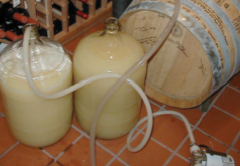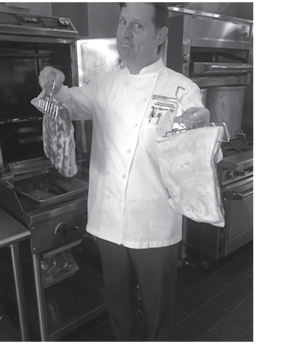
Many a home winery gets by just fine with no pump at all. If your hobby grows, though, you may find that many routine tasks are made simpler with the help of a wine pump. Some home winemaking jobs, like filtration or removing wine from barrels, may be virtually impossible without a pump.
In commercial wineries, pumps may be employed at every stage of winemaking. At home, the use of a pump is less likely at some stages. Beginning with grapes just in from the vineyard, the first place a pump might be used is at the destemmer. Most home winemakers destem and crush their grapes directly into the fermentation bins. While commercial wineries might have a heavy-duty must pump for transporting the crushed must, most of us at home just use buckets if we need to transfer. For home use, however, there are so-called “stirring destemmers” available. These machines include a hopper on top for the grapes, a mid-body section configured as a conventional destemmer with paddles and a grate, plus a lower sump with an integral must pump. As the grapes are destemmed, the must pump moves the thick must through an attached hose. At least 2.5 inches (6.4 cm) in diameter — and preferably 3 inches (7.6 cm) — the flexible hose delivers the de-stemmed must to a fermentation tank. As the pump is integral to this style of destemmer, it is not generally available to be a general-purpose wine pump for other tasks.
If white grape must is in a hopper from the crusher, it needs to be moved to a press. Here again, most home winemakers will use buckets. If a must pump is available, it can make the transfer directly. Red wine must resides in its fermentation tank for somewhat longer as the sugar is converted to alcohol and extraction of skin and seed components takes place. During that time, the “cap” rises up as skins are inflated by evolving carbon dioxide.
The cap must be mixed with the fermenting wine to assure effective extraction and prevent spoilage. One common technique is punchdown: A tool is used to submerge the cap and break it up. A pump is used with another technique: Pumpover, or remontage. The fermenting wine is drained from the tank into a reservoir, the cap drops and is allowed to stand for some time, then the wine is rapidly pumped back over the top. To achieve the rapid return using a pump, it should be configured to utilize hoses at least one inch (2.5 cm) inside diameter.
After red wine is fermented, it goes to the press. Here, too, a must pump could do the transfer. Otherwise, home winemakers use buckets to scoop out fermented must and place it in the press. If you have a pump suitable for pumpovers, you can ease the press transfer by draining the tank and pumping the free-run to barrels, tanks, or carboys before placing the wet pomace in the press with buckets. After the press, pumping the liquid to the next barrel or tank is faster and more efficient than filling a bucket, carrying it across the cellar, and pouring with a funnel. Since the juice or wine directly from the press contains some pulp, the pump used should be capable of passing soft solids without damage or obstruction. When it comes time to rack the wine, a pump can be very helpful. Indeed, if aging is done in barrels set on wooden blocks on the floor (as in my little wine cellar), it is almost impossible to rack without a pump. I like to pump out of the barrel into a stainless steel tank and wash the barrel. I then pump any topping carboys into the barrel, then refill from the tank. Remaining wine goes into carboys as the new topping wine.
The final stages for pumping include filtration and bottling. Some wine filters include an integral pump and sometimes it can be disconnected for separate use. A general purpose wine pump can be used for filtering through plates or cartridges. Because it must generate pressure against resistance, the pump needs to be of the “positive displacement” type as discussed later. For bottling, some systems allow for pumping directly to a filler while others need gravity flow. If using a gravity-flow filler, it can still be useful to pump the wine up into a reservoir and then allow it to drain into the filler. Some bottle fillers are equipped with integrated pumps.
PUMP OPTIONS: POSITIVE DISPLACEMENT VS. CENTRIFUGAL
Now that we have in mind those tasks around the home winery where a pump could help, we will get into the characteristics of pumps themselves. Wine pumps, for commercial or home use, generally fall into one of two broad categories: Positive displacement or centrifugal. Centrifugal pumps are uncommon at home. These pumps usually have an axial inlet pipe and a radial discharge. A motor spins an impeller that does not have a tight fit to the casing. Rather, it has blades somewhat like a propeller that spin the fluid to the outside rim. The liquid gathers there and is forced out by the continuing movement of new wine into the pump. Because the fit is not tight, the fluid can recirculate if resistance to flow occurs and a valve can be partially closed on the discharge side to throttle the flow. Such pumps deliver higher volumes at lower pressures than positive displacement pumps of similar size. They are not self-priming; they will not lift liquid into an empty pump head. Consequently, users tend to mount them below the source reservoir and allow them to fill by gravity before pumping on. Their use is found most often in large wineries with high-volume pumping requirements.
The other category, positive displacement, displays diverse operating principles. They may use pistons, diaphragms, flexible impellers, sliding vane impellers, or other motive devices. What they have in common is that a fixed amount of fluid is advanced with each rotation of the motor. Except for possible internal leakage around seals, that means the amount of wine pumped is essentially independent of the pressure. Because of that, output should generally be unrestricted (unlike a centrifugal pump) because damage may occur as pressure builds. A pump buyer should look for a pump with a safe maximum working pressure and, if available, variable speed control. With a fixed volume moving with each shaft rotation, flow is controlled by the motor speed. Variable frequency drives for pump speed control are the most sophisticated and energy-efficient way to alter the delivery rate of a positive displacement pumps. It may be possible to restrict inlet flow, but that may cause the pump to cavitate (spin without moving fluid) and run dry. Although positive-displacement pumps are generally self-priming (they will lift fluid into an empty pump head), most cannot be run for an extended period empty without damage. They rely on the fluid being transported to provide cooling and to lubricate seals.
IMPELLER PUMPS
In impeller pumps, there is a more-or-less round chamber in the pump head and the shaft may be off-center in it. As the motor rotates an impeller, a larger volume near the inlet is squeezed down to a smaller volume at the exit. That loads pressure onto the delivered wine and forces it out of the outlet fitting. To prevent loss of pumping efficiency, the impeller blades must wipe snugly along the inside wall of the pump chamber. For flexible impeller pumps, the blades bend against the side of the chamber to make the smaller sections and extend to full length near the entrance to provide for incoming wine. These pumps are sometimes sold with replacement impellers and service by the user is not difficult. Sliding vane pumps have panels that serve as impeller blades. On the low-volume side of the head, the panels are pushed into slots in the center shaft. As they rotate around to the inlet, centripetal acceleration slides them out against the chamber wall to make the larger inlet space. To facilitate the sliding and the seal at the edge, such vanes are sometimes made out of graphite. The sliding vanes are not usually user serviceable. Because of the tight fit required, solids may damage impeller pumps.
DIAPHRAGM PUMPS
On diaphragm pumps, a flexible membrane (the diaphragm) separates the pump head into a mechanical (dry) section and the fluid-filled (wet) section. A piston or other actuator deforms the diaphragm into the wet section and a one-way valve allows fluid to exit. The actuator withdraws, expanding the wet chamber, and more wine flows in through another one-way valve. The process is rapidly repeated, producing the characteristic clicking sound of such pumps. Solids may clog a diaphragm pump. Other pump designs may be more tolerant of solids, including peristaltic pumps, lobe pumps, and progressive cavity pumps, but none of these are common in home winemaking.
For materials of construction, most users favor stainless steel. Brass pump heads carry a historic concern about lead content, although modern brass pumps approved for potable water (or food contact) are certified to be low in lead. Even without the lead threat, copper in the brass alloy may dissolve in the low pH of wine and contribute to casse or oxidation. Seals and impellers may be made from a variety of polymers. Teflon, Viton, delrin, neoprene, and phenolic rubber may be employed. As a pump buyer, look for stainless steel and a manufacturer’s recommendation for use with drinking water as a guide for compatibility. Although the alcohol content of wine may cause accelerated wear for some polymers, it is not usually high enough to cause short-term pump damage. Wine-specific pumps from fermentation equipment manufacturers can be regarded as safe for use in your cellar.
SIZE YOUR PUMP
To size your pump, consider which of the applications you will employ. If you intend to pump must, you will be looking at 2.5 to 3 inch (6.4 to 7.6 cm) inside diameter (ID) hoses. These are very large pumps and are very expensive; most home winemakers will forego these applications. For white juice and red wine during fermentation, 1 inch (2.5 cm) ID is a good target. This only applies to pumping over or racking free-run wine, not moving pomace. For later racking, filtering, and bottling a pump with 1⁄2-inch (13-mm) to 3⁄4-inch (19-mm) hoses will usually suffice. Note that for filtering, the pump must be capable of delivering sufficient volume at sufficient pressure for the filter medium being employed. On smaller pumps that are not expected to move solids, a stainless steel screen prefilter will help protect the impeller from damage. Once you have decided on a hose size, you will want to consider pumping rate. A small diaphragm pump at 2 or 3 gallons per minute (gpm) (7.6 to 11.4 L/min) may be fine for a small operation, but that means 20 to 30 minutes to empty a standard 60-gallon (227-L) barrel. Many home wineries do very well with pumps that move between 4 and 10 gpm (15 and 38 L/min). Home winemaking shops, specialty wine equipment companies, and hardware stores all have pumps. From the ones available to you, look for wine compatibility (or at least potable water), materials of construction that you like, operating principle, flow rate, and connection size. Try to match with the intended use. For the smaller pumps described here, expect to pay about $150 to $500. For the larger ones, you may be looking at prices of $1,000 to $3,000. Most pumps for home use are configured for 110 volt use, but be aware that some imports have an expectation of 220 volt circuits.
When using your pump, keep in mind the same cleaning and sanitation principles you use throughout your wine production. When I use my pump, I pump a solution of sodium percarbonate through it for cleaning, recirculating it in a bucket. I then rinse with fresh water in another bucket, followed by a citric acid solution to neutralize any residual carbonate on the polymer surfaces. After a final clean water rinse, I run it dry just a few seconds to empty the hoses as thoroughly as possible. After pumping wine, I repeat the cleaning process. I then remove the hoses and hang them vertically to drain and air.
Because of the many decisions involved, use drives choice. First, decide how you will use your pump. That decision will go a long way toward solving the questions of type, size, material and pumping capacity. Whatever you choose, you will be able to say goodbye to some of the heavy lifting in your winery and let electrical power do the work.






